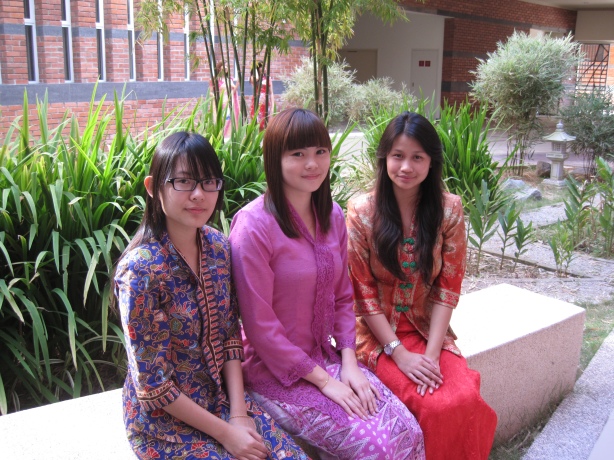In Malaysia, we are able to find people of different races, different cultures and of different religions.
Costumes of different cultural background:
Chinese (Samfoo & Cheongsam)

Chinese traditional costumes
Cheongsam
Cheongsam is known as a female dress with distinctive Chinese features and enjoys a growing popularity in the international world of high fashion.
1) It is easy to slip on and comfortable to wear.
2) It is made of different materials and to varying lengths.
3) They can be worn either on casual or formal occasions.
Samfoo
1) Worn by males
2)”Sam” in Cantonese means blouse and “foo” in the same dialect is trousers.
3) They can be worn either on casual or formal occasions.
Malay (Baju Melayu, Baju Kurung and Baju Kebaya)

Malay traditional costumes
Baju Melayu (“Malay dress or attire”) is the general term for the traditional Malay costume for the Malay men.
1) Worn either with a sarong or trousers
2) Worn rightly with matching pants or trousers.
3) Worn during Friday prayers.
4) They can be worn either on casual or formal occasions.
Baju Kurung
1) It is known as the traditional Malay female costume.
2) Originate from the Malaysian state of Johore about 200 years ago.
3) Embroidery are sewn to the dress for an elegant look.
4) They can be worn either on casual or formal occasions.
Baju Kebaya

Baju Kebaya
Kebaya is a traditional Indonesian clothing design.
1) One of the favorites among the traditional Malay costumes especially during the 1960’s.
2) Made according to the wearer’s size.
3) Worn with the kain songket or batik.
4) The kebaya (the upper part of this dress) which is usually tight-fitting and short.
5) The baju kebaya’s design is not so complicated.
6) They can be worn either on casual or formal occasions.
Indian (Saree & Kurtha)

Indian traditional costumes
Saree
The Saree is a traditional garment for women.
1) It comprises a long single piece of fabric, approximately 5.5 meters in length and 1 meter in width, expertly wound around a woman’s body, with the loose end thrown over the shoulder.
2) Worn with a choli, or short, fitting blouse, the fabric itself can be very detailed.
Kurtha
The traditional item of clothing worn in Afghanistan, Bangladesh, India, Pakistan, Nepal, and Sri Lanka.
1) They were traditionally worn with loose-fitting paijama (kurta-paijama), loose-fitting salwars, tight-fitting churidars, or wrapped-around dhotis; but are now also worn with jeans.
2) A loose shirt falling either just above or somewhere below the knees of the wearer, and is worn by both men and women.
3) They can be worn either on casual or formal occasions.
Natives (Kelabit, Kayan and Melanau)

The costume of Malaysian Natives
Kayan
1) The Orang Ulu velvet costume is richly decorated with beads, sequins and beautiful motifs.
2) It is also known as ‘Basung’ and ‘Ta’ah’
Melanau
1) The wedding costume of yesteryears called ‘Serebaeng’ or ‘Bajo Baban’ modeled by Melanau ethnic maiden.
2) These are blouse fashioned from satin or velvet and shawl decorated with silver or gold pieces.
Kelabit
1) The costume is known as Sa’ban.
2) Usually handmade with beads as decoration.
3) Wore with a cap and necklace made out of beads.
3) Wore during formal occasions.
















